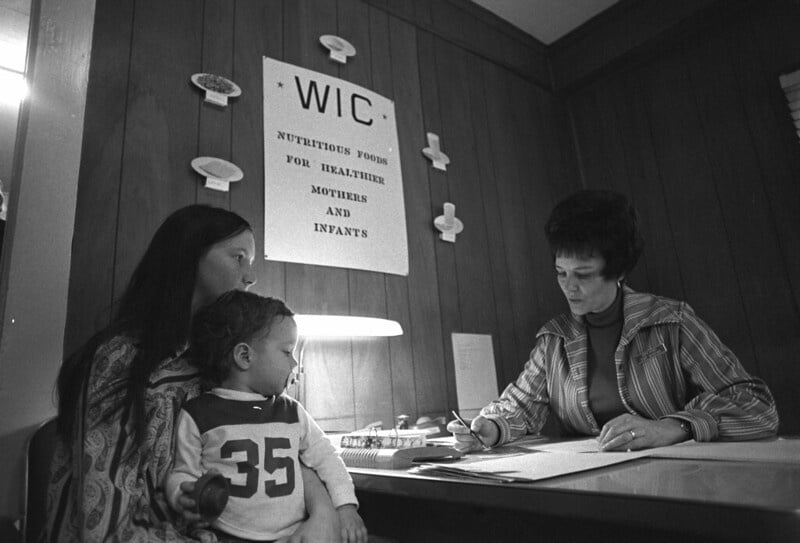
A mother signs up to receive food supplements utilizing the USDA’s WIC food nutrition program in Pineville, Kentucky in January 1974. (via flickr/National Archives and Records Administration)
The U.S. Department of Agriculture has proposed changes to the Special Supplemental Nutrition Program for Women, Infants, and Children (WIC) “food package” rules. These rules determine the exact items you can buy with WIC benefits, down to the brand, type, and size.
The 50-year-old WIC program aims to help meet the special nutritional needs of pregnant, breastfeeding, and non-breastfeeding postpartum women as well as infants and children up to five years of age who are at nutritional risk due to being low-income. But the food package rules, though meant to help ensure a family’s health and nutrition, are often a burdensome constraint.
According to the USDA website, the USDA has now proposed changes to the rules that would
- provide WIC participants with a wider variety of foods that align with the latest nutritional science;
- provide WIC state agencies with greater flexibility to prescribe and tailor food packages that accommodate participants’ special dietary needs and personal and cultural food preferences;
- provide more equitable access to supplemental foods;
- and better promote and support individual breastfeeding goals of participants to help establish successful long-term breastfeeding.
The problem with the current WIC food guidelines
Due to low participation in WIC in our region, in recent years Just Harvest has conducted several surveys and solicited comments among previous and current WIC participants about the barriers they face in getting and using WIC. Transportation to appointments and participating stores was consistently the biggest challenge. However, food package restrictions and the negative impact they had on recipients’ shopping experiences were consistently near the top of this list.
The families we heard from cited food package restrictions as a key reason that WIC was not as helpful to their family. The limited choice of dairy products, milk, and types of whole grains they were allowed to buy meant they could not use the benefit to incorporate food that met cultural preferences, or dietary allergies or needs.
“Our children have a rare disorder, GSD. There needs to be an alternate milk has too much sugar, there is too much milk in the package.”
“We’re lactose intolerant, but also worry about too much soy in our kids’ diets.”
Similarly, the restrictions on package sizing made the shopping experience more challenging. One family noted that they picked up a 48oz bottle of juice, rather than a 64oz bottle of the same brand and type, only to have a problem at the checkout counter. Another noted the store they were shopping at was out of the allowed cereal package size. They couldn’t use WIC to buy their preferred brand that day even though there was some on the shelf.
These are common occurrences. Finding the correct package size or brand package adds confusion to the WIC shopping experience, resulting in further checkout stigma and general frustration.
We get 36 oz of cereal. Some stores don’t have 12 oz (buy 3) or 18 oz (buy 2), they stock 11.5 oz or 13.5 oz., so I can’t buy it and then my kids take a loss!”
It was hard to find the precise food.”
What works about WIC food package rules
Families also reported that what they loved about WIC was that it made healthy eating easier, as well as meal planning. They like being able to buy more fruits and vegetables for their families.
Using WIC helps make meal planning and making healthy choices easier. Being limited
to only purchasing things that are nutritionally dense makes snacking easier. Building
well rounded meals is also much easier.”“Without WIC, my family would NOT have had access to the amounts and quality of
food, fruits/vegetables, dairy and formula, that they needed to thrive!”
Our recommendations
The USDA had a public comment period on the proposed food package rule change. We submitted the above quotes as well as our thoughts on the specific policies.
We expressed concern over the USDA’s proposed trade-off reducing the allowed amount of some foods (like milk) to pay for the addition of other foods (like canned fish). Some WIC clients will not welcome this change, whose only purpose is cost savings.
We did applaud USDA for the other aspects of the food package rule change that increase shopper choice, and we support their effort to:
- make permanent the recent increases in fruit and vegetable benefit, which would provide 50% of fruit and vegetable intake recommended by the Dietary Guidelines for Americans (DGAs); permanently increasing the value of the fruit and vegetable benefit each month
from $9 to $25 for children and from $12 to $44-$49 for pregnant and postpartum participants; - add seafood across the children and adult food packages;
- enhance the variety of healthy choices for WIC families by establishing new substitution patterns that increase access to dairy and Cash Value Benefit;
- provide more substitution options for milk (yogurt, lactose-free milk, nondairy milk) and eggs;
- include a broader range of cultural whole grain options, like quinoa, teff, and blue cornmeal;
- expand package size ranges across all food categories to allow a broader range of approved products on the grocery store shelf;
- create a pathway for new products that are nutritionally comparable with WIC foods to be approved, such as plant-based dairy alternatives, in order to better accommodate WIC participants with a variety of dietary preferences and allergies; and
- strengthen standards for companies that manufacture WIC-approved products – including cereals and dairy – to improve child health outcomes by increasing whole grain intake and reducing sugars and saturated fats.
We also recommend to the USDA that to support these food package changes they
- require state and local agency vendor training, resources, support, oversight, and appropriate stocking rules; and
- provide ample support to increase the availability of authorized WIC stores in underserved areas.
Because what good is WIC if the people who need it most have nowhere nearby to shop with the benefits? That is a key problem beyond the scope of this rule change, but is something Just Harvest also works on.
![]() Learn more about WIC
Learn more about WIC
![]() See if you’re eligible for WIC using our screening tool
See if you’re eligible for WIC using our screening tool




No comments yet.